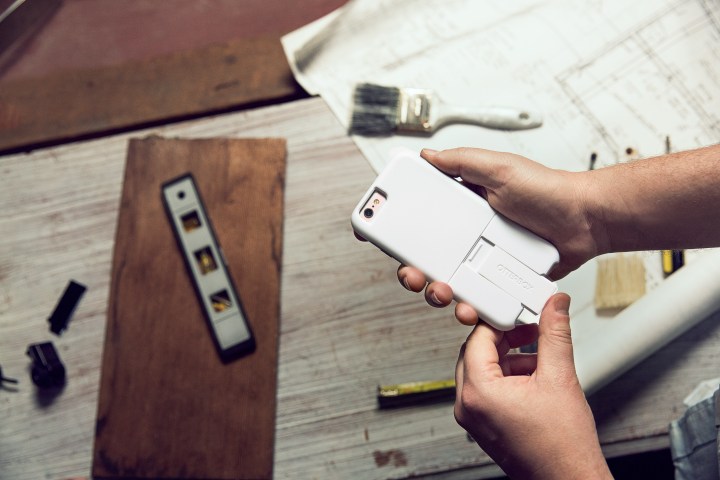
The Universe Case System is designed for the iPhone 6, 6S, 6 Plus, and the 6S Plus, but it’s is not about one phone case. It’s a platform that utilizes modules from various manufacturers like Square, Polar Pro, SanDisk, Seek Thermal, Goal Zero, and Olloclip. These modules attach to the back of the case, after you slide out a little plastic cover.
The case itself is $50, but the price will rack up once you start adding modules.
Right out of the bat, Polar Pro has a ton of modules for the OtterBox Universe, including the Tripper Tripod, a $50 tripod that can transform into a grip and extension pole; the Stance Compact Tripod, a $30 folding tripod; the PowerPack, a $50 battery pack; Beat Pulsar Wireless Mobile Speaker, a $60 speaker; the Fisheye, a $30 wide-angle lens; and more.
- 1. Seek Thermal
- 2. SanDisk
- 3. Polar Pro Pulsar
- 4. Olloclip
The bottom of the case is open and so is the front, leaving it open for damages in case you drop it. The sides of the case do offer additional bumper support, and the company says the Universe meets Certified Drop+ Protection standards. But protection isn’t the point with the Universe — OtterBox has opted for a something different, and it’s not like it needs another drop-proof case to add to its lineup.
Other modules add more functionality, like Square’s Contactless and Chip Reader, a $50 tool that lets small businesses accept payments from their phones; the Olloclip 4-in-1 lens, a $80 lens that lets you switch between fisheye, wide-angle, 10x and 15x lens; SanDisk’s iXpand Flash Drive, a module that adds up to 128GB of additional storage capacity; and more.
Modules for phones are becoming popular offerings from manufacturers — LG based its new G5 smartphone around its “Friends” platform. You can add modules like a camera grip with dedicated shutter and video record buttons, as well as one that enables high-definition audio. LG’s experiment doesn’t seem to have gained the traction it wanted, especially after it failed in offering most modules at launch.
Google is also experimenting with a modular phone from its Advanced Technology and Projects division. Project Ara wants to let people easily swap out cameras, speakers, battery packs, and more. A developer kit will be available this year, and Google first Project Ara phone will launch in 2017.
It’s hard to tell yet if consumers are interested in modular upgrades for their phones, but OtterBox has come out with a whole lot to choose from, and it’s likely that more modules will be on the way if the platform is successful.
The Universe Case System is available now in white and black on OtterBox’s website, but you’ll be able to buy it from Best Buy’s retail stores and Amazon on May 29.
Editors' Recommendations
- One of the most iconic iPhone accessories is back — and it’s great
- iPhone 16: news, rumored price, release date, and more
- 5 phones you should buy instead of the iPhone 15
- iPhone SE 4: news, rumored price, release date, and more
- 3 reasons why I’ll actually use Anker’s new iPhone power bank






